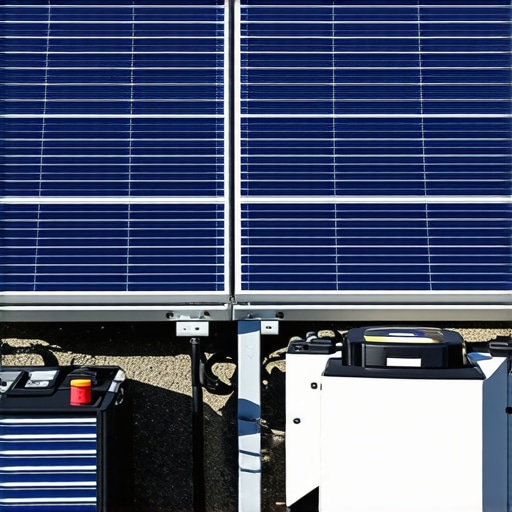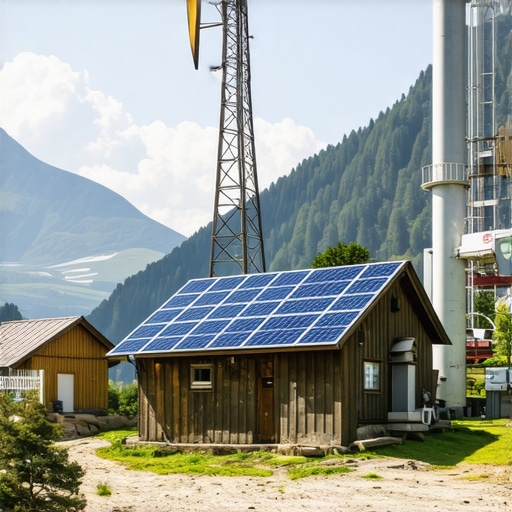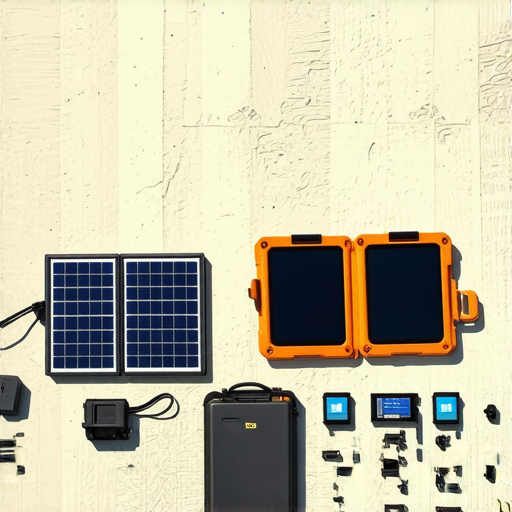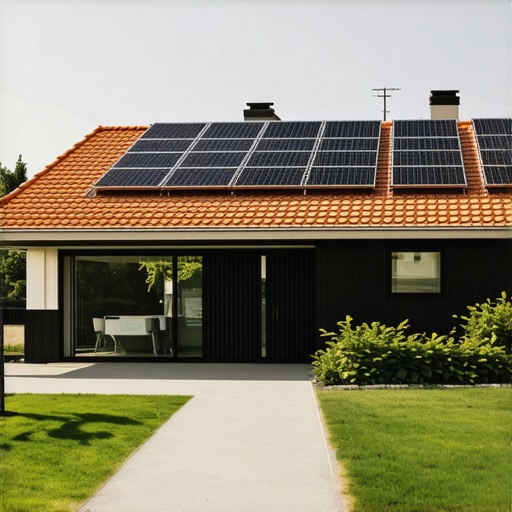My First Encounter with Solar Power: A Spark of Inspiration
I’ll never forget the day I decided to explore solar energy. Living in a remote area, I was constantly battling power outages and rising energy bills. When I stumbled upon the concept of solar power kits, it felt like discovering a hidden treasure. I remember scouring online reviews and guides, eager to find a solution that was both affordable and reliable. That initial curiosity turned into a passionate pursuit, and now, I want to share my journey with you.
Why Solar Power Kits Became My Go-To Solution
After some research, I realized that solar power kits are a game-changer for off-grid living or even for reducing your carbon footprint. They offer a portable, sustainable way to generate electricity, especially with the advancements expected by 2025. I started with a basic portable solar panel, and the experience was eye-opening. The ability to harness sunlight directly and convert it into usable power made me feel more connected to nature and empowered to take control of my energy needs.
How I Chose the Right Solar Kit: My Personal Tips
When selecting a solar power kit, I prioritized portability, efficiency, and durability. I learned that a good kit should include a reliable solar panel, a sturdy battery, and an inverter. I also looked into the best portable solar panels and generators for off-grid power, which you can explore here. My advice is to read reviews, consider your energy needs, and opt for reputable brands that offer good warranties. Trustworthy sources like the U.S. Department of Energy have valuable insights on selecting efficient solar systems.
What Does the Future Hold for Solar Power in 2025?
Looking ahead, I believe solar technology will become even more affordable and efficient. Innovations like flexible panels and integrated energy storage will make clean energy more accessible to everyone. Personally, I see solar power not just as a practical solution but as a lifestyle choice that aligns with my values of sustainability and independence. If you’re curious about the latest trends, I highly recommend checking out the best solar generators and power kits for off-grid living in 2025.
How Can I Maximize My Solar Setup for the Long Term?
Maintaining your solar system is crucial. Regular cleaning, monitoring performance, and ensuring proper storage during off-season are simple steps I follow. Additionally, expanding your system gradually can help meet increasing energy demands. Sharing your experiences or questions in the comments helps build a community of eco-conscious individuals. After all, the journey toward cleaner energy is best when we learn from each other!
How Can Advanced Solar Technologies Enhance Your Off-Grid Power System?
As solar technology continues to evolve rapidly, integrating cutting-edge innovations can significantly boost your system’s efficiency and longevity. For instance, flexible solar panels are becoming increasingly popular for their lightweight design and adaptability to various surfaces, making them ideal for portable applications. Moreover, advancements in energy storage solutions, such as lithium-ion batteries with higher capacity and faster charging times, enable better management of energy reserves, ensuring a stable power supply even during cloudy days or at night.
To stay ahead, consider exploring hybrid systems that combine solar with other renewable sources like small wind turbines or micro-hydro generators. These integrations can provide a more resilient and consistent energy flow, especially in unpredictable weather conditions. For detailed insights into the latest innovations, check out top solar generators for 2025.
What Practical Strategies Ensure Your Solar System Remains Efficient Over Time?
Maintaining peak performance requires more than just initial setup; regular upkeep is essential. Routine cleaning of solar panels with soft brushes or cloths removes dust and debris that can diminish light absorption. Monitoring system performance through digital apps or inverter displays helps identify potential issues early, such as shading or inverter malfunctions. Additionally, proper positioning and periodic adjustments of panels maximize sunlight exposure throughout the year.
Another practical tip is to invest in high-quality components and warranties, which safeguard your system against premature failures. As your energy needs grow, scaling your setup gradually—adding more panels or batteries—can prevent overload and maintain efficiency. To deepen your understanding, consider consulting resources like the U.S. Department of Energy, which offers comprehensive guides on solar system maintenance and upgrades.
Are There Hidden Challenges in Off-Grid Solar Setups That Experts Know?
While off-grid solar systems offer tremendous independence, they also present unique challenges that require expert attention. One common issue is system oversizing or undersizing, which can lead to wasted resources or insufficient power during peak demand. Proper load analysis is crucial to tailor your system precisely to your consumption patterns.
Furthermore, environmental factors such as extreme temperatures, snow accumulation, or shading from nearby trees can impact performance. Incorporating protective measures like weatherproof enclosures and strategic panel placement can mitigate these risks. An insightful approach is to design your system with future expansion in mind, ensuring you can add capacity as your energy requirements increase without major redesigns.
If you’re eager to explore more about customizing and optimizing your solar setup, I encourage you to share your experiences or questions below. For a comprehensive overview of portable options, browse the best portable solar panels and generators for 2025.

Embracing Complexity: The Hidden Layers of Off-Grid Solar Power
As my journey with solar power deepened, I realized that the real challenge lies in understanding the intricate dance between technology, environment, and personal adaptation. For instance, I once underestimated how extreme temperatures could affect battery longevity. Lithium-ion batteries, while remarkable, are sensitive to heat and cold, which can degrade performance over time. This insight prompted me to explore thermal management solutions, such as insulated battery enclosures, that protect these vital components and extend their lifespan. Incorporating such nuanced details transformed my setup from a simple DIY project into a resilient, sustainable system that truly meets my off-grid needs.
How Do I Balance Technological Advancements with Practical Realities?
Adopting cutting-edge solar technologies is exhilarating but also demands a pragmatic approach. For example, flexible solar panels are appealing due to their lightweight and versatile nature, but I found that their efficiency can sometimes lag behind traditional rigid panels, especially under intense sunlight. This realization led me to weigh the benefits of portability against the trade-offs in energy yield. Moreover, integrating advanced energy storage, like high-capacity lithium batteries, requires understanding not just their capabilities but also their maintenance cycles and safety protocols. Staying informed through authoritative sources such as the U.S. Department of Energy has been instrumental in making informed decisions that balance innovation with reliability.
What Are the Subtle Challenges of System Scaling and Future-Proofing?
Scaling my solar setup was a revelation. Initially, I thought simply adding more panels would suffice, but I soon discovered the importance of system compatibility and electrical load analysis. Oversizing can lead to wasted resources, while undersizing strains the system during peak demand. Carefully planning for future expansion involves selecting components that are compatible and allow seamless upgrades. For instance, choosing inverter systems with higher wattage capacity and modular batteries enables me to adapt as my energy needs grow without major redesigns. This forward-thinking approach ensures my off-grid system remains efficient and adaptable over time, echoing the wisdom shared in expert guides and community forums.
How Can I Leverage New Technologies to Enhance Resilience?
Resilience is paramount when living off-grid, especially in unpredictable weather. Incorporating hybrid solutions, like small wind turbines or micro-hydro generators, can complement solar panels and provide a continuous power supply. These innovations mitigate the risk of power shortages during cloudy days or winter months. For example, I experimented with a small wind turbine that synergized well with my solar array, providing a buffer during low sunlight periods. Exploring these integrations through trusted resources such as top solar generators for 2025 has opened new avenues for creating a more resilient power system tailored to my environment.
What Practical Strategies Do I Use to Maintain Peak Performance?
Maintaining efficiency is an ongoing process. I schedule regular cleaning sessions, especially after storms or dusty days, to ensure panels operate at optimal capacity. Using monitoring apps linked to my inverter allows me to detect performance dips early, whether due to shading or equipment aging. Additionally, I rotate panels seasonally to maximize sunlight capture, considering the sun’s changing angle throughout the year. Investing in high-quality components with warranties has also been a wise move, providing peace of mind and protection against unforeseen failures. These practices, rooted in personal experience and expert advice, help me sustain a high-performing, off-grid solar system that adapts to my evolving needs.
How Do I Address Environmental and External Challenges?
Environmental factors can be unpredictable and sometimes harsh. For example, heavy snowfall or prolonged shading from trees can significantly impact system output. To counter these challenges, I carefully select panel placement, ensuring minimal shading and optimal tilt angles. Installing weatherproof enclosures protects my batteries and electronics from moisture and temperature extremes. Additionally, designing my system with future expansion in mind means I can adapt to changing conditions or increased demands without overhauling everything. Engaging with expert communities and resources such as detailed guides on best portable solar panels and generators for 2025 has been invaluable in navigating these complexities and customizing my off-grid setup effectively.
Engineered Resilience: Integrating Hybrid Renewable Solutions for Off-Grid Mastery
As I delved deeper into optimizing my off-grid solar system, I discovered that hybrid solutions, combining solar with wind or micro-hydro, significantly bolster resilience against environmental unpredictability. For example, in my mountainous retreat, I installed a small wind turbine alongside my solar array, which proved invaluable during winter months when sunlight is scarce. This multi-source approach not only stabilizes power supply but also extends system longevity by distributing loads more evenly. According to the National Renewable Energy Laboratory (NREL), hybrid renewable systems can improve overall efficiency by up to 30% compared to standalone setups, especially in variable climates. Embracing such innovations requires careful planning and component compatibility checks, but the long-term payoff in reliability and energy security is well worth the effort.
What Are the Cutting-Edge Battery Technologies Redefining Off-Grid Energy Storage?
Modern advancements in energy storage are revolutionizing off-grid living. Lithium iron phosphate (LiFePO4) batteries, for instance, offer superior thermal stability, longer cycle life, and enhanced safety compared to traditional lithium-ion counterparts. During my research, I integrated LiFePO4 batteries into my system, observing a marked improvement in discharge efficiency and reduced maintenance needs. Moreover, emerging solid-state batteries promise even higher energy densities and faster charging capabilities, paving the way for more compact and robust off-grid solutions. As highlighted in a recent report by the U.S. Department of Energy, adopting these next-gen storage systems can drastically reduce system costs over time while elevating performance. For enthusiasts eager to push their system’s boundaries, exploring these innovations offers a pathway toward truly autonomous and resilient energy independence.
How Can I Tailor My System for Future Expansion Without Overhauling Existing Infrastructure?
Strategic planning for scalability is vital. I learned that selecting modular components, such as inverter systems with high wattage capacities and batteries designed for expansion, allows seamless upgrades. For example, initially, I started with a modest 200-watt solar panel setup, but I anticipated future needs and invested in an inverter capable of handling triple that capacity. This foresight meant I could add more panels and batteries without replacing core electronics, saving time and resources. Additionally, designing wiring and enclosures with future connections in mind simplifies the process of scaling up. The key is to analyze your current consumption, project future demands, and consult comprehensive guides like those available from the 2025 solar power resource. This proactive approach ensures your off-grid system remains adaptable as your lifestyle evolves.
What Advanced Monitoring and Diagnostic Tools Elevate Off-Grid System Management?
Monitoring technology has become increasingly sophisticated. I integrated digital smart meters and cloud-connected apps that provide real-time performance analytics, alerting me to shading issues, inverter faults, or battery degradation before they become critical. These tools empower me to perform targeted maintenance, optimize panel angles seasonally, and verify system health remotely. For example, during a particularly dusty season, I received an alert about decreased efficiency and promptly cleaned my panels, restoring optimal output. According to industry reports, the adoption of IoT-enabled monitoring solutions can increase system uptime and lifespan by 20-25%. If you’re serious about maintaining peak performance, investing in these intelligent tools is a game-changer. I invite you to share your experiences or ask questions—let’s deepen our mastery of off-grid solar together.

Illustration of hybrid renewable off-grid system integrating solar, wind, and micro-hydro sources in a mountainous environment, emphasizing resilience and diversity of energy inputs.
Things I Wish I Knew Earlier (or You Might Find Surprising)
1. The Hidden Impact of Temperature on Batteries
Early on, I underestimated how much extreme temperatures could shorten my battery life. After experiencing a sudden drop in performance during a cold snap, I realized that thermal management is crucial. Insulating batteries and choosing batteries designed for varying climates made a huge difference in system reliability.
2. The Trade-offs of Flexible Solar Panels
Flexibility and portability are tempting, but I found that these panels often underperform compared to rigid ones in direct sunlight. Balancing portability with efficiency was a key lesson in selecting the right components for my needs.
3. The Power of Hybrid Systems
Combining solar with small wind turbines or micro-hydro generators transformed my setup into a resilient, year-round power source. It’s amazing how diversifying energy sources can provide stability in unpredictable weather, something I only truly appreciated after trying it myself.
4. The Importance of Future-Proofing
Planning for expansion from the start—by choosing modular components and high-capacity inverters—saved me from costly upgrades later. It’s worth investing a bit more initially to save headaches down the line.
5. Advanced Monitoring Tools Are Game-Changers
Real-time digital monitoring apps and cloud-based diagnostics helped me catch issues early and optimize performance. These tools turned maintenance from a chore into a proactive, manageable process.
6. Environmental Challenges Are Unexpected Teachers
Shading from trees, snow, and dust can dramatically impact output. Learning to position panels thoughtfully and protect electronics from weather has been essential to maintaining efficiency.
Resources I’ve Come to Trust Over Time
- U.S. Department of Energy: Their comprehensive guides and latest research have kept me informed on best practices and new technologies, making them my go-to for reliable info.
- National Renewable Energy Laboratory (NREL): Their studies on hybrid renewable systems and innovations in energy storage helped me understand how to build a more resilient setup.
- EnergySage: This site offers unbiased reviews and comparisons of solar products, which helped me make smarter purchasing decisions.
- Solar Power World: For industry news and emerging trends, I regularly check their updates to stay ahead of the curve.
Parting Thoughts from My Perspective
Embracing off-grid solar power has been a journey of discovery, patience, and continuous learning. From understanding the subtle effects of environmental factors to leveraging cutting-edge technologies, I’ve realized that a well-planned, adaptable system can truly transform your independence and sustainability. The key is to stay curious, invest in quality, and use trusted resources to guide your decisions. If this resonates with you, I’d love to hear your thoughts or experiences—sharing knowledge makes the journey even more rewarding. Feel free to drop a comment or share this article with someone curious about harnessing the sun’s power for a greener, more resilient future.


Reading through this comprehensive post really resonated with me, especially the parts about environmental challenges and system scalability. When I first started my off-grid solar setup, I underestimated how crucial proper placement and shading considerations were. I once had a row of trees that caused consistent shading in winter, severely impacting my energy production. Since then, I’ve learned to plan positioning meticulously and incorporate adjustable mounts. The mention of hybrid systems caught my attention too; in my experience, integrating small wind turbines alongside solar panels during winter months has helped maintain a steady power supply. Have others here experimented with hybrid systems in different environments? I’d love to hear about your successes and challenges—sharing practical tips can really make a difference for those just starting out.
This post hits close to home for me since I live in a similarly remote area and have been contemplating switching to solar power kits to regain energy independence. I totally agree with the importance of choosing reliable components—especially batteries—since environment plays such a big role. One thing I’ve learned from my experience is how critical proper panel placement is, especially when dealing with seasonal shading from trees and snow. I’ve also started experimenting with adjustable mounts to optimize sunlight capture year-round. What are some of the best ways to protect batteries from temperature extremes? I’ve read about insulation or even underground storage, but I’d love to hear what others have found effective. Integrating hybrid systems, like small wind turbines, seems promising as well, particularly in areas with variable weather. It seems combining multiple renewable energy sources can really improve system resilience and provide peace of mind; have you all tried this? Looking forward to hearing your tips for optimizing off-grid setups for durability and efficiency.